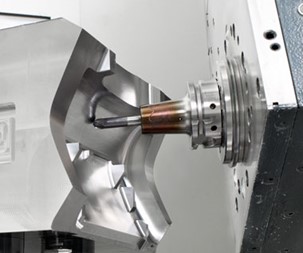ในภาคอุตสาหกรรมการผลิตทุกวันนี้ มีการพัฒนาและออกแบบเครื่องจักรใหม่ๆ ให้สอดคล้องกับกระบวนการผลิตมากยิ่งขึ้น จากความต้องการที่เน้นตอบสนองเรื่องเวลาในการผลิตชิ้นงาน (Cycle time) รูปแบบชิ้นงานที่มีความซับซ้อน (Complex part) และคุณภาพผิวงานที่ดีขึ้น (Good surface finish)
ดังนั้นผู้ผลิตจึงมีการเพิ่มศักยภาพต่างๆ ของเครื่องจักร ดังเช่นการเพิ่มประสิทธิภาพของความเร็วรอบของสปินเดิล (Spindle Speed) ให้สูงมากกว่า 10,000-40,000 รอบ/นาที เพื่อให้เป็นไปตามเป้าหมายการผลิตและสามารถสร้างผลกำไรได้มากขึ้น ดังนั้นจึงจำเป็นเลือกใช้รูปแบบอุปกรณ์จับยึดเครื่องมือ (Tool Holder) ให้มีคุณภาพและมีประสิทธิภาพด้วยเช่นกัน
MEGA Tech ขอแนะนำ เทคโนโลยีจับยึดเครื่องมือ อุปกรณ์จับยึดเครื่องมือตัด (Tool Holder) ที่ตอบโจทย์ทุกรูปแบบงานตัดเฉือน โดยแต่ละอุตสาหกรรมและแต่ละงานล้วนแล้วแต่ต้องการระบบจับยึดเครื่องมือตัดที่แตกต่างกันออกไป ไม่ว่าจะเป็นงานตัดเฉือนความเร็วสูงไปจนถึงงานกัดหยาบ HAIMER มีผลิตภัณฑ์อุปกรณ์จับยึดเครื่องมือตัด (Tool Holder)และเทคโนโลยีจับยึดเครื่องมือตัดที่เหมาะกับทุกความต้องการ
หากกล่าวถึงการใช้ อุปกรณ์จับยึดเครื่องมือตัด (Tool Holder) ให้เกิดประสิทธิภาพนั้น จะต้องคำนึงถึง 3 องค์ประกอบดังนี้
- ความแข็งแรง (Rigidity & Clamping force)
- ความแม่นยำ (Accuracy & precision)
- ความสมดุล (Balance & safety)

ซึ่งปัจจุบันสิ่งที่ผู้ผลิตชิ้นส่วนอุตสาหกรรมต่างๆ มักมุ่งเน้น เรื่องความแข็งแรงและความแม่นยำของ อุปกรณ์จับยึดเครื่องมือตัด (Tool Holder) เป็นหลัก ซึ่งทางปฏิบัติโรงงานอุตสาหกรรมส่วนใหญ่จะตรวจสอบแต่เพียง ค่า Static Run – out เท่านั้น และนำไปใช้งานต่อ แต่ที่จริงแล้วเรื่องการตั้งค่าความสมดุลของ อุปกรณ์จับยึดเครื่องมือตัด (Tool Holder) เป็นสิ่งที่สำคัญ และ ขาดไม่ได้ด้วยเช่นกัน เมื่อเกิดกรณีการใช้ความเร็วรอบสูงมากเกินไป จะส่งผลให้เกิดความไม่สมดุล (Unbalance) ซึ่งจะมีผลกระทบต่างๆ ดังนี้
- สปินเดิลของเครื่องจักรเกิดการสั่นสะเทือน (Vibration) ทำให้เกิดการสึกหรอก่อนกำหนด
- อายุการใช้งานของเครื่องมือตัดสั้นลงหรือทำให้เกิดการแตกหักชำรุดเสียหาย
- คุณภาพของผิวชิ้นงานออกมาไม่ดี ซึ่งต้องใช้เวลาในการผลิตมากขึ้น เสียเวลาในการทำงานมากขึ้น
สาเหตุต่างๆ ที่ทำให้ อุปกรณ์จับยึดเครื่องมือตัด (Tool Holder) เกิดความไม่สมดุล
- การที่รูปแบบเครื่องมือตัดไม่สมมาตร ดังเช่น กลุ่มเครื่องมือตัดพิเศษต่างๆ (Special Tool)
- ข้อบกพร่องต่างๆ ของการออกแบบรูปทรงของ อุปกรณ์จับยึดเครื่องมือตัด (Tool Holder) หรือวัสดุที่ใช้ไม่เหมาะสม
- การเพิ่มอุปกรณ์ต่างๆ ไปรวมอยู่ที่ อุปกรณ์จับยึดเครื่องมือตัด (Tool Holder) เช่น การต่อความยาว , Pull stud, Screw เป็นต้น
หลักการทำงานสำหรับ การ Balancing อุปกรณ์จับยึดเครื่องมือตัด (Tool Holder)
1. การคำนวณหาค่า Balancing of อุปกรณ์จับยึดเครื่องมือตัด (Tool Holder) Permissible Residual Unbalance เพื่อนำค่าดังกล่าวไปถ่วงสมดุล (Balancing) โดยการเพิ่มหรือลดน้ำหนักที่ตัว อุปกรณ์จับยึดเครื่องมือตัด (Tool Holder) และทดสอบที่ Balancing Machine


- เกณฑ์ของการ Balance แต่ละกระบวนการผลิต ตามมาตรฐาน ISO1940
G 4000 – เพลาข้อเหวี่ยง / การขับของเครื่องยนต์ดีเซลที่มีจำนวนกระบอกสูบไม่สม่ำเสมอ
G 100 – ระบบเครื่องยนต์ (เบนซินหรือดีเซล) สำหรับรถยนต์ รถบรรทุกและหัวรถจักร
G 40 – ล้อรถ, ชุดล้อและเพลาขับ
G 16 – ส่วนประกอบเฉพาะของเครื่องยนต์สำหรับรถยนต์รถบรรทุกและหัวรถจักร
G 6.3 – เครื่องมือ เครื่องจักรและชิ้นส่วนเครื่องจักรทั่วไป
G 2.5 – การหมุนของเครื่องมือตัดสำหรับเครื่องจักรซีเอ็นซี
G 1 – เครื่องเจียรไน
G .4 – แผ่นดิสก์และงานเจียระไนที่มีความละเอียดสูง ซึ่งในปัจจุบันส่วนใหญ่ในการผลิตชิ้นส่วนต่างๆ งานแม่พิมพ์ งานอากาศยาน และ งานอุตสาหกรรมยานยนต์ จะนิยมใช้เกรด G2.5 อีกทั้งยังมีเครื่องจักรที่ช่วยในการ Balancing ของ Tool Holder เพื่อเป็นมาตรฐานและสะดวกมากยิ่งขึ้น ดังรูปภาพที่ 2

- วิธีการ balancing ของ อุปกรณ์จับยึดเครื่องมือตัด (Tool Holder) มี 4วิธีหลักๆ คือ
- การลดน้ำหนักโดยการเจาะ (Drilling)
- การลดน้ำหนักโดยการกัด (Milling)
- การเพิ่มน้ำหนักโดยขันสกรู
- การเพิ่มน้ำหนักโดยใส่แหวนรอง (Ring)ซึ่งวิธีการทั้งหมดนี้จะต้องทำการปรับพารามิเตอร์ทั้งหมดที่ซอฟต์แวร์ของ Balancing Machine เช่น ขนาดของสว่าน ความลึกรูเจาะ องศาปลายดอกสว่าน เพื่อที่จะคำนวณหามวลและทดสอบการ Balance ได้อย่างถูกต้อง

- รูปแบบงานที่จำเป็นสำหรับการนำ Balancing ไปประยุกต์ใช้ที่ให้เกิดประสิทธิภาพ
- ลักษณะงานที่จับด้ามยาว ที่ความเร็วรอบต่ำ และมีรูปร่างขนาดใหญ่
- ลักษณะงานที่จับด้ามยาว ที่ความเร็วรอบสูง สำหรับงานเก็บละเอียด
- สำหรับเครื่องมือตัดที่มีขนาดเล็ก (Micro Cutting Tool)
- สำหรับเครื่องมือตัดพิเศษ (Special Tool)
- ข้อดีของสำหรับการ Balancing มีหลายประการดังนี้
- ยึดอายุการใช้งานของสปินเดิลเครื่องจักร
- สามารถเพิ่มความเร็วรอบและอัตราป้อนได้มากยิ่งขึ้น
- สามารถลดเวลาในการทำงานได้ (Reduce Cycle time)
- เพิ่มอายุการใช้งานและประสิทธิภาพของเครื่องมือตัด
- สามารถปรับปรุงคุณภาพผิวได้ดีขึ้น
- ใช้งานเครื่องจักรให้มีประสิทธิภาพอย่างเต็มที่
จากข้อมูลต่างๆ ตามที่ได้กล่าวมาเบื้องต้นนั้น การ Balancing ถือว่ามีความสำคัญเป็นอย่างมากสำหรับการผลิตสมัยใหม่ที่ต้องการควบคุมเวลา รูปร่าง และคุณภาพผิวชิ้นงาน จำเป็นจะต้องเรียนรู้หลักการและการนำไปประยุกต์ใช้อย่างถูกต้อง เพื่อจะทำให้เกิดประสิทธิภาพสูงสุดต่อการทำงานปัจจุบัน
Article by: Haimer & MEGA Tech
https://www.haimer.com/en << Click Here












